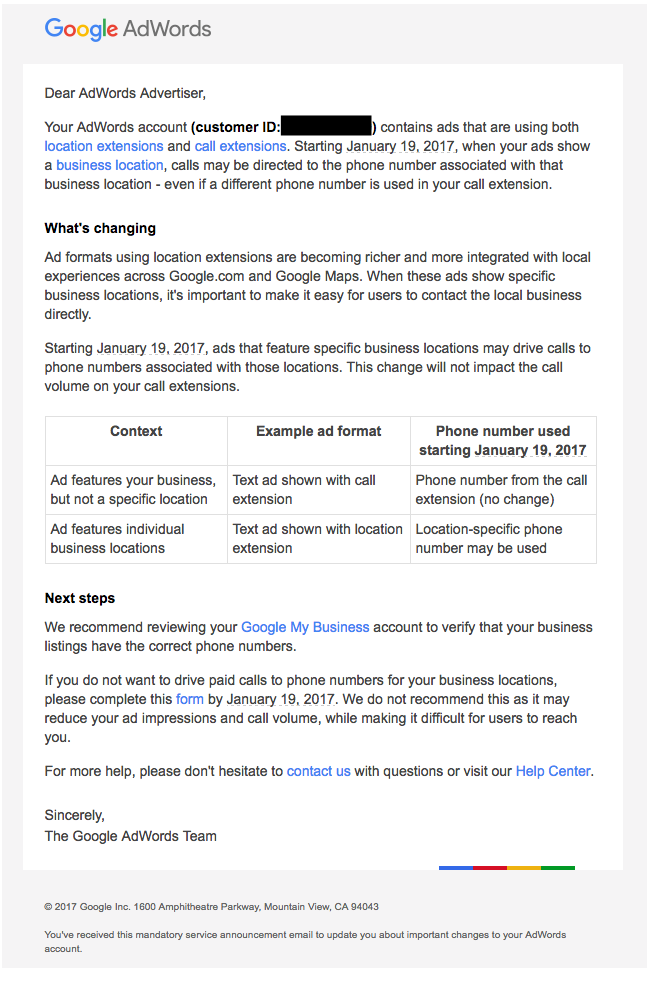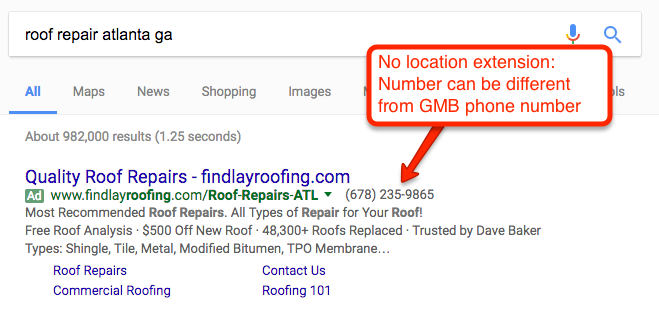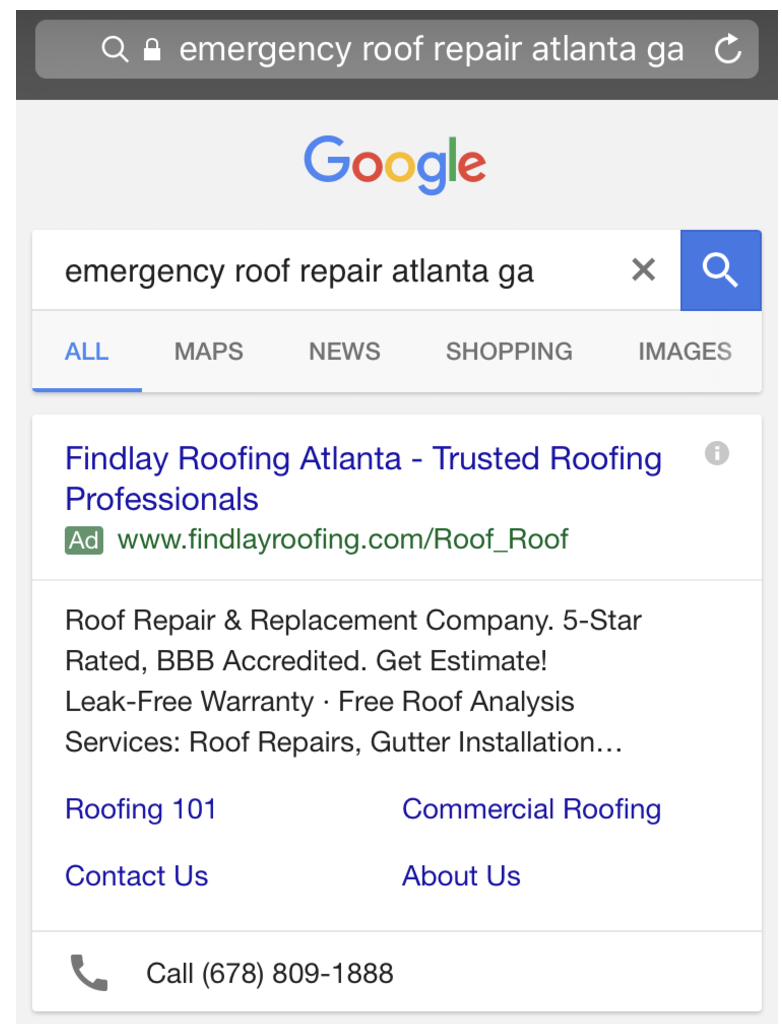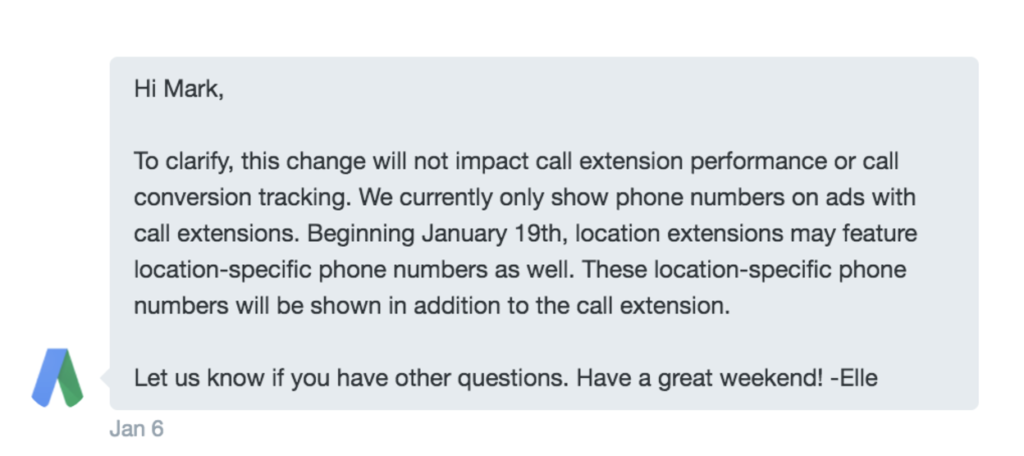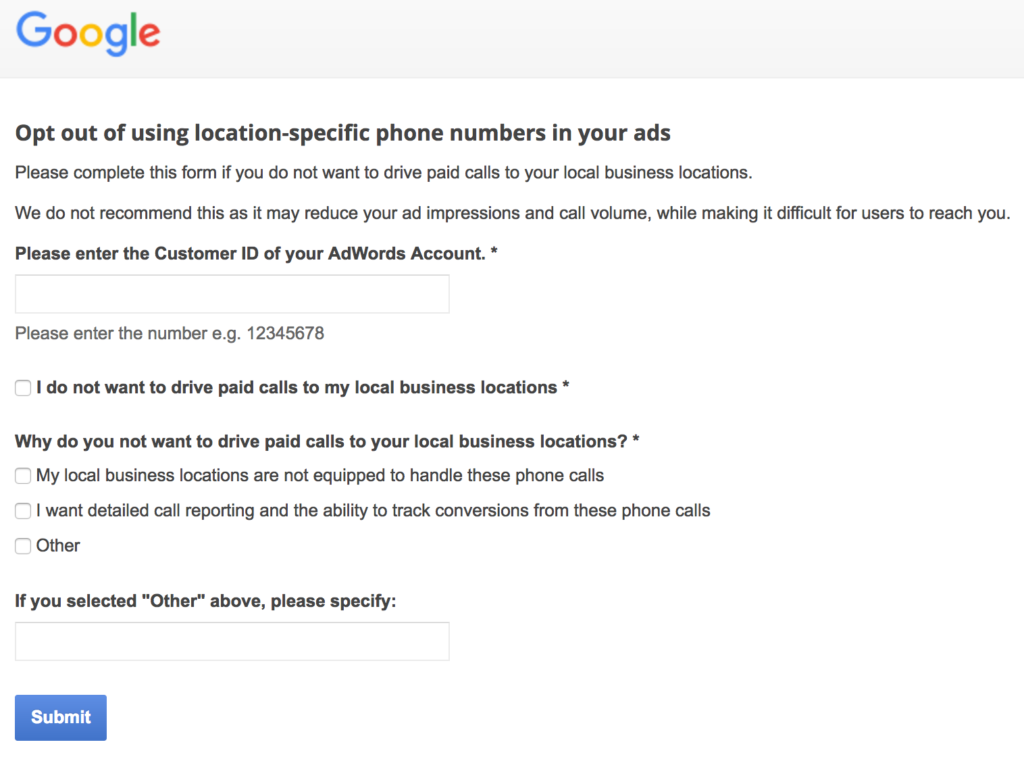Thursday afternoon we began receiving word of an email announcement from Google Ads (formerly AdWords) indicating that the phone numbers for location based ads on Google could be overridden by the phone number in the business’s Google My Business (GMB) listing. After looking into this more and confirming with a contact at Google, it looks to be a legitimate change.
I’d like to dive into what this change is, what it means for marketers who like clean call attribution data, and one possible way to still get call data from calls coming in via a Google My Business number.
(Here’s the ‘too long; didn’t read’ version: this change doesn’t seem to make much sense, is a step backwards for data-driven marketers, and there’s likely more to it that we will find out soon.)
Here’s a scrubbed copy of the actual email from Google:
Since this particular announcement has no corresponding statement or post officially from Google, we have to rely on the email being sent to advertisers.
Who does this change affect?
The change affects any advertiser using Google Ads call extensions and location extensions, where the call extension phone number is different from the business location’s phone number in Google My Business. The main group of marketers affected by this change are likely to be those using third party call tracking software who use Ads to drive phone calls to specific business locations. For example, franchise marketers using multi-location call tracking for business locations could see their paid call conversion data mix with their call volume from their main line listed in Google My Business. Those who are tracking all calls from local search by using a main line tracking phone number in their GMB will be less affected by this change; however, they will still lose granular attribution for some phone call conversions.
Why did Google make this change?
At first glance, the change looks commensurate with Google’s efforts to display verifiable information about a particular business location to searchers. There was plenty of outcry from marketers when Ads began requiring phone number verification for call extensions in 2015. While that change was likely to combat spam, it nonetheless created an extra step for many of us who use call tracking numbers on Google Ads’ ads.
The same could be surmised about this change–that it’s intended to increase searcher’s trust in the data. After all, why should a searcher see a different number in an Ads location extension than the phone number in the same business’s GMB profile?
Upon closer inspection of the wording of the announcement, I’m not so sure that’s the reason behind this change. First of all, it’s not so clear *when* Google will display the number listed in GMB on paid ads. The key sentence seems to be this one (emphasis mine):
Starting January 19, 2017, ads that feature specific business locations may drive calls to phone numbers associated with those locations.
If the change were related to Google’s efforts to make the business information searcher’s see more trustworthy or consistent, I doubt the announcement would be ambiguous about whether they will show the GMB number. Also, a searcher could still see a different number from a business’s main number if the ad format is not featuring a “specific business location”.
So, here’s two ad formats that point to the oddness of this announcement:
Call Extension on desktop ad, not affected by this change:
Location extension on desktop ad showing phone number, affected by this change:
Here’s another 2 examples from my iPhone:
Call Extension on mobile ad, not affected by this change:
Location extension on mobile ad showing phone number, affected by this change:
The difference in the examples above seems minimal and arbitrary, yet this is what Google is saying in the email. When I inquired about the change to AdWords support via Twitter, I received a response that only adds to the confusion:
If we’re to combine the announcement with the message from Ads Support above, we’re left with the impression that there will be two phone numbers displayed in the event that an advertiser is using a separate call extension number along with a location extension. In this scenario there appears to be no over-riding of the call extension number, rather an addition of the location specific phone number alongside the call extension number. Two phone numbers doesn’t sound like a very pleasant experience for the average searcher.
New ad format on the way (for Android Auto)?
I imagine we don’t have the entire story here but I can imagine that there’s a new ad format in the works. Perhaps the announcement and its rushed timeline came about because of a scenario like the following (note: this is pure speculation):
Google had been working on a new ad format set to be released soon that will pull data directly from verified GMB profiles. This ad format is perfectly suited for something like Android Auto or a new iteration of Google Maps, the latter of which the company has been trying to monetize for years. They planned on selling this through Ads Express, which has received more attention of late from Google, and they realized that this new ad format was going to contradict the call extensions many advertisers had already set up in Ads. They make an announcement via email with the rushed timeline, which is right around the launch of the new ad format.
I have no idea how accurate the above scenario might be, but it does seem likely that we don’t have the whole story here. Several marketers on Twitter expressed frustration about he rushed timeline, including the person who first noted the change, Rachel King:
How to avoid or mitigate the effects of this change
There is only one way to completely avoid this change affecting your call conversion data: to opt-out of the change. In the announcement is a link to an opt-out form, which is obviously written to discourage advertisers from opting out. Below is a screenshot of the form.
Part of the problem with opting out is that if you want to use location extensions in your ads and include a phone number, opting out would seemingly prevent you from doing that.
There is one way to mitigate the change–Use a main line tracking phone number to track all calls from organic (website + listings like GMB). This method is outlined in this call tracking for local search guide I wrote for Mike Blumenthal’s blog and an advanced follow up post I did recently. This method still mingles paid calls with organic calls (from GMB or elsewhere); however, it still allows for the collection of call analytics that are derived from call recordings. More on what you can gain from automated analysis of call recordings on this page describing CallRail’s CallScore.
Overall, this is bad news for data-driven marketers
Regardless of why Google has decided to make this change, call tracking numbers play an integral role in evaluating the effectiveness of our PPC campaigns. The information we get from these numbers helps us be better marketers, make more relevant ads, and get more insight into what’s working and what’s not. Not being able to tie a call and call recording directly back to the particular ad, search term, or ad group that drove it is frustrating, especially when you’re used to getting that data.
Unfortunately, this Ads’ change appears to diminish advertisers’ ability to use third party call analytics tools to learn more about the phone calls driven by paid ads. Interestingly, this is one of the first changes I’ve seen from Google Ads that hamstrings data-driven marketers from learning more about the performance of their ads. While we’re still not completely sure how this change will affect advertisers using location extensions and call extensions in their ads, it seems to be a step in the wrong direction.




